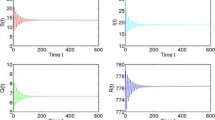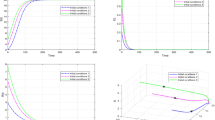Abstract
An infection-age structured epidemic model with a nonlinear incidence rate is investigated. We formulate the model as an abstract non-densely defined Cauchy problem and derive the condition which guarantees the existence and uniqueness for positive age-dependent equilibrium of the model. By analyzing the associated characteristic transcendental equation and applying the normal form theory presented recently for non-densely defined semilinear equations, we show that the SIR (susceptible-infected-recovered) epidemic model undergoes Zero-Hopf bifurcation at the positive equilibrium which is the main result of this paper.
Similar content being viewed by others
References
Capasso V, Serio G. A generalization of the Kermack-Mckendrick deterministic epidemic model. Math Biosci, 1978, 42: 43–61
Ducrot A, Liu Z, Magal P. Essential growth rate for bounded linear perturbation of non densely defined Cauchy problems. J Math Anal Appl, 2008, 341: 501–518
Inaba H, Sekine H. A mathematical model for Chagas disease with infection-age-dependent infectivity. Math Biosci, 2004, 190: 39–69
Kellermann H, Hieber M. Integrated semigroups. J Funct Anal, 1989, 84: 160–180
Kim M Y. Existence of steady state solutions to an epidemic model with screening and their asymptotic stability. Appl Math Comput, 1996, 74: 37–58
Kim M Y, Milner F A. A mathematical model of epidemics with screening and variable infectivity. Math Comput Modelling, 1995, 21: 29–42
Liu W M, Hethcote H W, Levin S A. Dynamical behavior of epidemiological models with nonlinear incidence rates. J Math Biol, 1987, 25: 359–380
Liu W M, Levin S A, Iwasa Y. Influence of nonlinear incidence rates upon the behavior of SIRS epidemiological models. J Math Biol, 1986, 23: 187–204
Liu Z, Magal P, Ruan S. Hopf bifurcation for non-densely defined Cauchy problems. Z Angew Math Phys, 2011, 62: 191–222
Liu Z, Magal P, Ruan S. Normal forms for semilinear equations with non-dense domain. J Differential Equations, 2014, 257: 921–1011
Magal P. Compact attractors for time-periodic age structured population models. Electron J Differ Equ Conf, 2001, 2001: 1–35
Magal P, Ruan S. On integrated semigroups and age structured models in L p spaces. Differ Integral Equ, 2007, 20: 197–239
Magal P, Ruan S. On semilinear Cauchy problems with non-dense domain. Adv Differential Equations, 2009, 14: 1041–1084
Magal P, Ruan S. Center manifolds for semilinear equations with non-dense domain and applications on Hopf bifurcation in age structured models. Mem Amer Math Soc, 2009, 202: 2559965
Ruan S, Wang W. Dynamical behavior of an epidemic model with a nonlinear incidence rate. J Differential Equations, 2003, 188: 135–163
Thieme H R. Semiflows generated by Lipschitz perturbations of non-densely defined operators. Differ Integral Equ, 1990, 3: 1035–1066
Thieme H R. Integrated semigroups and integrated solutions to abstract Cauchy problems. J Math Anal Appl, 1990, 152: 416–447
Thieme H R. Quasi-compact semigroups via bounded perturbation. In: Advances in Mathematical Population Dynamics: Molecules, Cells and Man. River Edge: World Scientific, 1997, 691–713
Thieme H R. Differentiability of convolutions, integrated semigroups of bounded semi-variation, and the inhomogeneous Cauchy problem. J Evol Equ, 2008, 8: 283–305
Zhang Z, Peng J. A SIRS epidemic model with infection-age dependence. J Math Anal Appl, 2007, 331: 1396–1414
Acknowledgements
This work was supported by National Natural Science Foundation of China (Grant Nos. 11471044 and 11371058) and the Fundamental Research Funds for the Central Universities. The authors are grateful to the referees for their valuable comments and suggestions which helped us to improve the presentation of the paper.
Author information
Authors and Affiliations
Corresponding author
Rights and permissions
About this article
Cite this article
Liu, Z., Yuan, R. Zero-Hopf bifurcation for an infection-age structured epidemic model with a nonlinear incidence rate. Sci. China Math. 60, 1371–1398 (2017). https://doi.org/10.1007/s11425-016-0371-8
Received:
Accepted:
Published:
Issue Date:
DOI: https://doi.org/10.1007/s11425-016-0371-8




